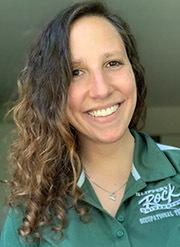Alliance woman part of team stressing new opioid treatment

 Courtney Barker Submitted Photo
Courtney Barker Submitted Photo
SLIPPERY ROCK, Pa. — Prior to the COVID-19 pandemic, the top priority for health officials in Pennsylvania was the opioid epidemic. The state’s 36.1 rate of drug overdose deaths per 100,000 residents was among the top five in the nation. Recognizing this crisis, a faculty-student research team at Slippery Rock University is advocating for the treatment of opioid addiction through occupational therapy.
“Opioid addiction is only going to get worse because of the pandemic,” said Courtney Barker, a graduate student majoring in occupational therapy from Pittsburgh. “For people who are recovering from addiction, (the pandemic) can be an even more stressful time and it’s important for people not to be thrown off their routines and structure in their lives.”
That’s where occupational therapy comes in. Three occupational therapy graduate students and their professor are conducting research to better understand how performing meaningful daily activities, or occupations, help people recover from opioid addiction.
“An occupational therapist is going to help an individual live their life,” Kim Keeley, associate professor of exercise and rehabilitative sciences, who is the study’s faculty mentor and instructor of the Scholarship in Occupational Therapy class. “When most people hear the word ‘occupation’ they think about their jobs, but occupation is used interchangeably with activity, as in ‘I’ve done five occupations today,’ such as taking a shower, running an errand or fulfilling their role as a parent. We’re looking at the things that fill people’s days, and how these activities help maintain a healthy lifestyle.”
Keeley guided the research team that included Amy Hoover, a graduate student majoring in occupational therapy from Alliance; Barker; and Kristen Japuncha, a graduate student majoring in occupational therapy from Hermitage.
The SRU researchers worked with 54 people who are recovering from opioid addiction through a local outpatient counseling center. Participants completed questionnaires rating the positive and negative attributes to their recovery and the meaningfulness of various occupations, or what the researchers called “activities of daily living,” or ADLs. Additionally, researchers interviewed eight patients in a focus group.
“The biggest thing we found is how important ADLs were,” Hoover said. “There were some basic tasks that they weren’t doing during their addiction. All they cared about was seeking that drug because the drug was their occupation and there was nothing else to fill that void. Everyone’s experience was different but we were able to find common themes.”
Three qualitative themes emerged: influences leading to recovery, barriers to successful recovery and behaviors associated with recovery. The most common positive attributes to recovery were family, medication and counseling, while friends, finances and stress were the most common negative attributes related to their recovery.
“We found that the process for recovery is very individualized and it was sometimes difficult to categorize,” Hoover said. “For example, family could show up as both positives and negatives, depending on if a person relies on family for support or maybe with their family is where the drug use occurs.”
“The main thing is when they are engaging in meaningful activities and having structure and a routine, that helped them maintain sobriety,” Barker said. “They kept themselves busy so that they didn’t go back to using drugs.”
The findings of the study can help guide programming for occupational therapists to implement with individuals as treatments to their recoveries.
“As occupational therapists, we can facilitate the engagement and activities of daily living,” Barker said. “If they are struggling to identify what’s meaningful, we can help them reflect on the activities or find new occupations to engage in. We can assist with job exploration and develop skills and interpersonal skills, healthy habits, routines and roles.”
“A big part of occupational therapy is that transitional phase,” Hoover said. ”(A recovering addict) can seem fine in a rehab facility and that they’re ready to return to normal life, but transitioning into their home life and having the things they need is hugely important. That’s where there’s often a disconnect and they can regress when they get home.”
The SRU study began in fall 2018 as part of a research component of SRU’s Doctor of Occupational Therapy degree program, and continued through each of the students’ last three semesters. The students’ final year of the three-year program will consist of field work and a separate capstone research project. They hope to have their findings published in an academic journal.
“This was my first big research project and it will benefit me for my capstone,” said Barker, who plans to work at Pittsburgh VA Medical Center hospital studying suicide prevention. “A lot of what I found in this research supports my advocacy for occupational therapy’s role at bigger mental health facilities.
“I hope that this gives people hope that they can recover by changing their lives and doing little things that will make a big impact.”
For more information about SRU’s occupational therapy doctoral program, visit the program’s webpage.
 Pathways Drug Rehabilitation Luxury Addiction Treatment & Detox Center
Pathways Drug Rehabilitation Luxury Addiction Treatment & Detox Center


